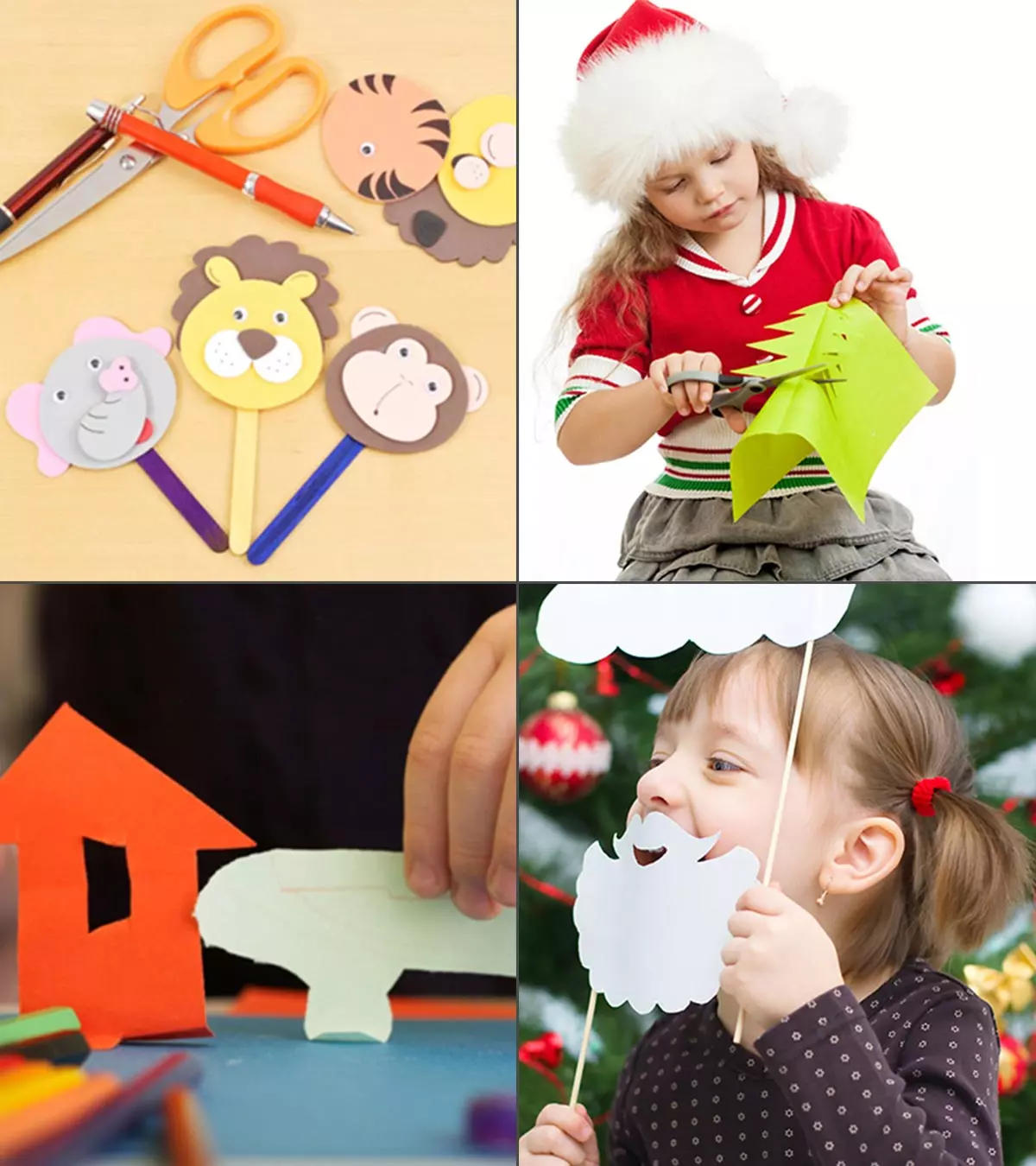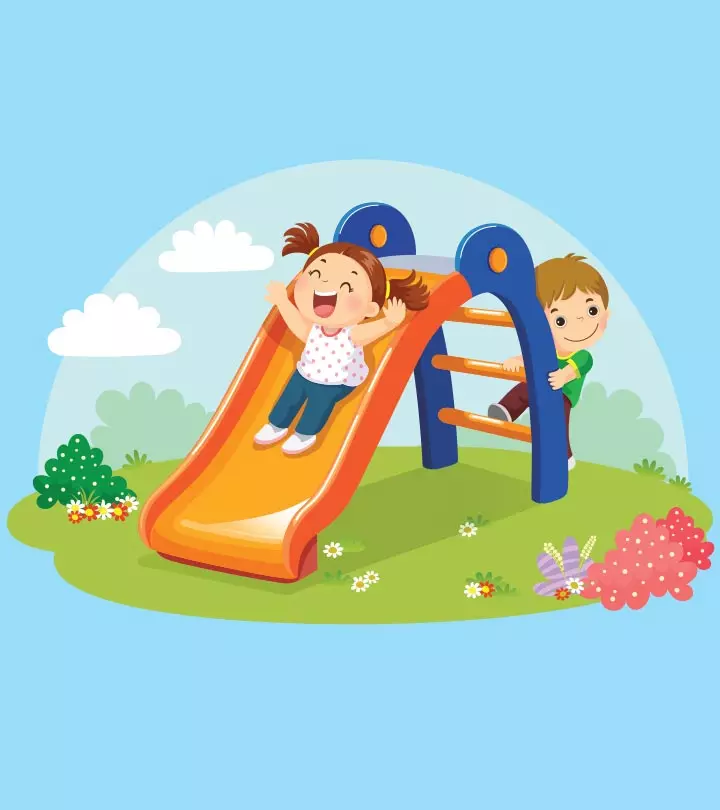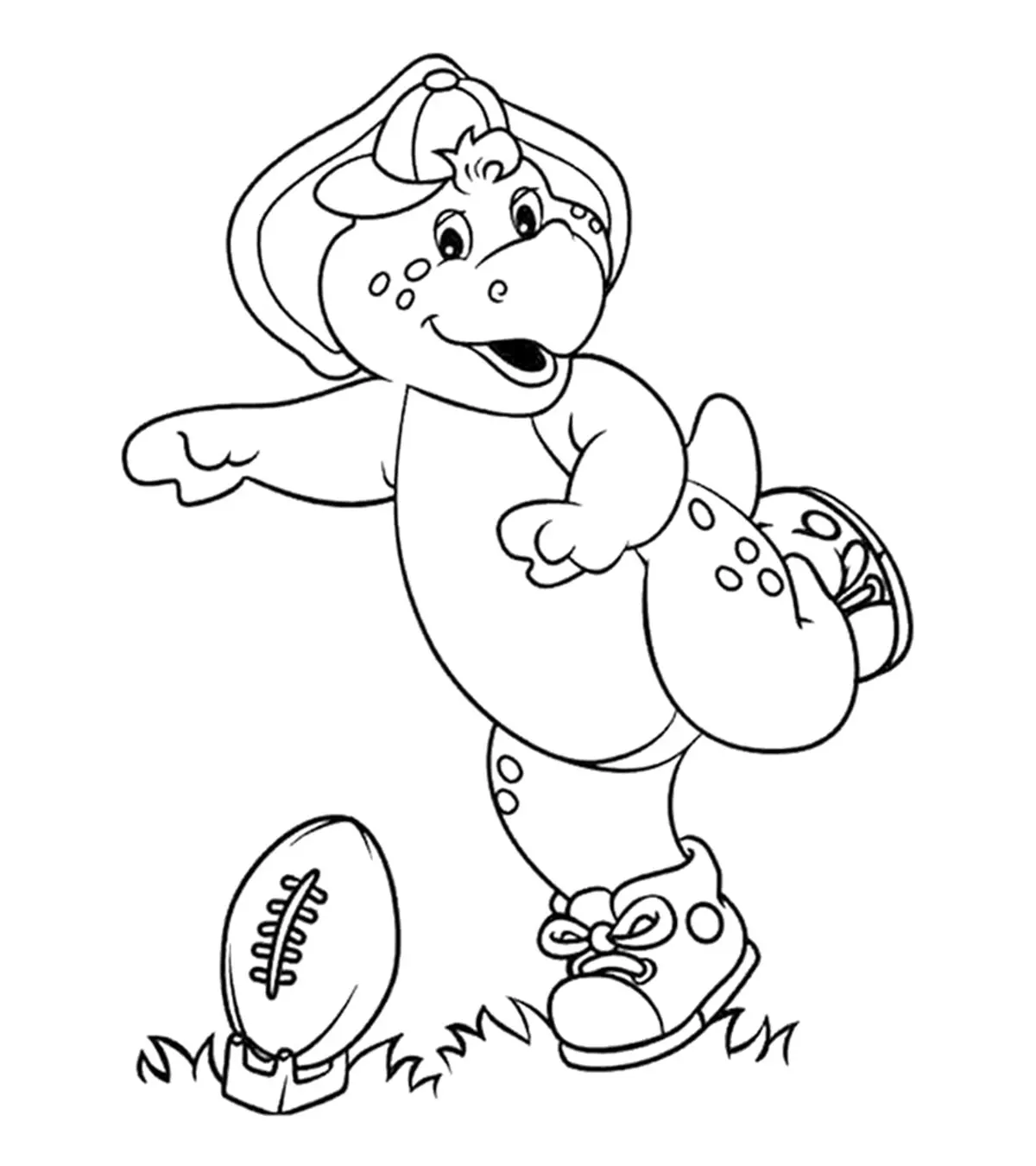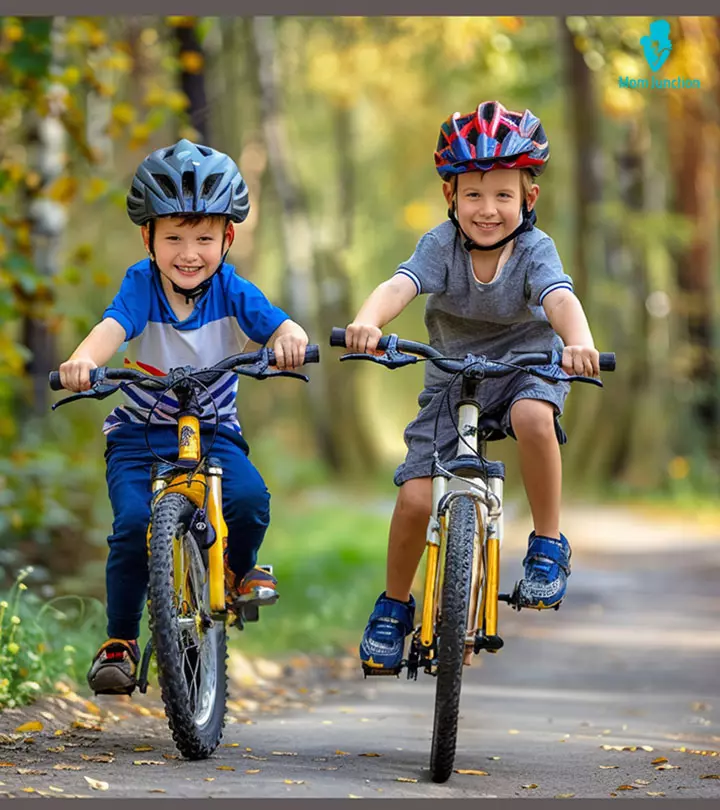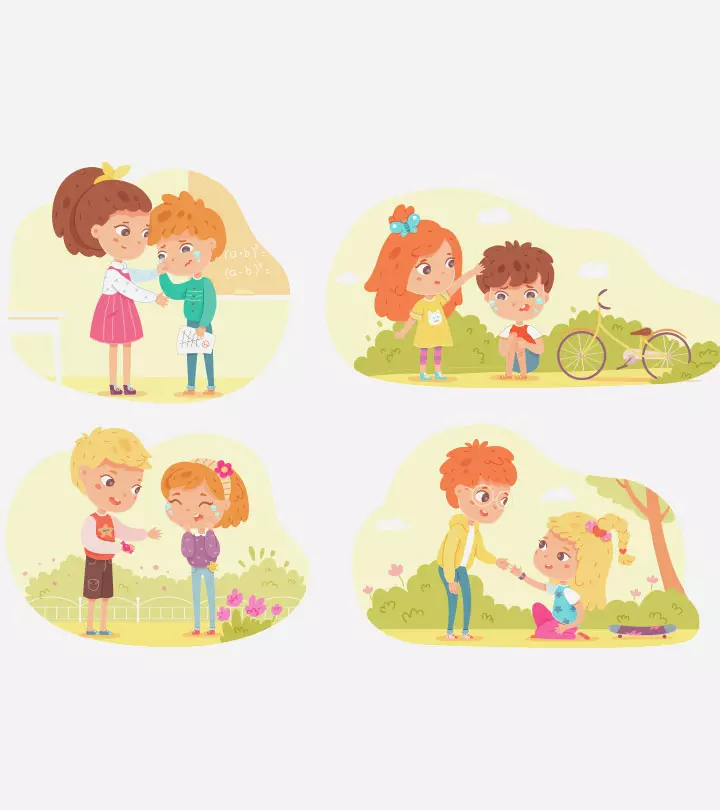
Image: iStock
Empathy is the ability to sense other people’s feelings or “the ability to put oneself in someone’s shoes.” Empathy is not just a moral value; it lets children gather social development. By engaging in empathy activities, children learn to navigate their emotions and develop stronger emotional intelligence, which is essential for forming healthy relationships. So, empathy activities for kids are a way to bring kindness and compassion to build relationships. When children learn how other people may feel, they become careful with their actions and words. They tend to empathize or feel the pain the other person is going through and similarly can feel joy in the other person’s happiness. Empathy is relating and mirroring others’ feelings without any selfish motive.
Here, we have compiled a list of empathy activities to teach the importance of kindness to your children.
Key Pointers
- Empathy is understanding and feeling other’s emotions and experiences.
- Empathy activities like labelled feelings, photo books, board games, and role-playing can help children develop empathy.
- Practicing acts of kindness and modeling helpfulness can encourage children to be empathetic towards others.
- Parents and teachers can lead by example and show empathy towards others to teach children empathy.
- Encouraging empathy and kindness in children can promote positive relationships and make the world a better place.
16 Empathy Activities For Kids
You can practice empathy activities at home or school for children to make positive and strong connections with others.
1. Labeled feelings
Create a scenario and ask the children to label their feelings when put in those situations and how they react. For example, being bullied, witnessing bullying, or being the bullies themselves. They may express anger, rage, sadness, frustration, fear, and pain.
Here you need to explain not to let their emotions overpower them. They need to channel these feelings in the right direction and not act violently. Teach them that situations such as bullying can be stopped if they are empathetic and help each other understand. You should be working in cooperation with the children to better understand their feelings and work towards correctly channeling their emotions.
2. Photo books
A fun way to understand emotions is by relating them to people’s expressions and different situations. Here, the photo book will have photos of children’s friends and family members, each labeled with emotions reflecting the situation or people in the photo. When children go through those photos, they will be able to understand the emotions behind different expressions and situations. Matching facial expressions with emotions helps them understand what a feeling looks like.
3. Board games
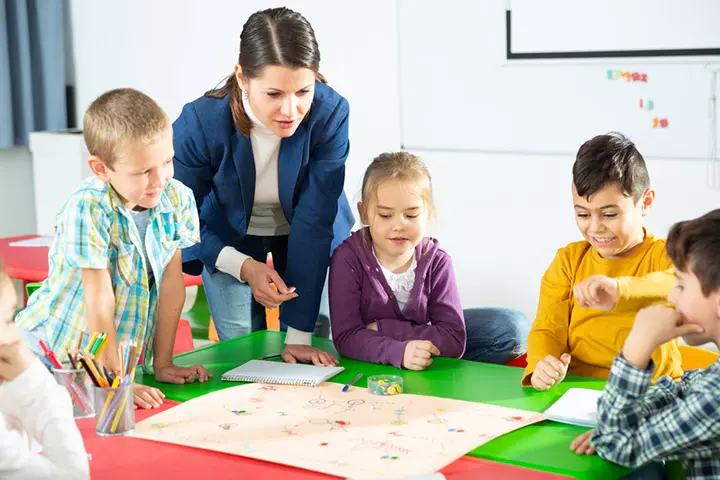
Image: Shutterstock
Several board games, such as “friends and neighbors” or “guess how I feel?” help children understand kindness, care, and helpfulness. The former requires to assess the situation displayed on the board and place a card with the action they would perform for the situation. In the latter, they need to guess the other person’s feelings in a given situation. You may get one for your children and play with them to make them aware of others’ feelings.
4. Acts of kindness
As the saying goes, “a simple act of kindness goes a long way,” this activity involves encouraging children to be kind through their actions. Gather the children in a group and begin by asking them about any kind deed they have done and how they feel about it. Next, ask them to do something helpful and kind for another person in the group and have them report to you after they are done.
This helps children reflect upon their actions and understand that kindness makes both the persons receiving it and offering it happy. It will thus motivate them to extend more help and be kind as they grow.
 Point to consider
Point to consider5. The Golden rule
Ask children whether they would like it if they were mocked or made fun of. Or if they were left out of a party when all the others were invited? The answer would be no. You need to tell them about the golden rule–treat others how you want to be treated. They need to understand that if a particular action or word hurts them, it is not fair for them to do or say the same to someone else. This way, they will develop a better sense of conflict-resolution and more positive relationships with their friends and peers. It also aids in emotional development in children by increasing the skill of understanding perspectives and having forgiveness in their hearts.
6. Modeling helpfulness
Helping and caring for someone is one of the most significant signs of being empathetic. Make children understand that being insensitive and rude to someone will do no good to either of the persons and instead turn them into enemies. Use examples of stories, movies, books, pictures, or puppet shows to represent helpfulness. Pick the ones that show how respecting others’ feelings and caring for them can induce a sense of joy in both persons. Consider citing real-life examples from the news or community events to discuss how individuals can show empathy in various situations. This helps children connect empathy with real-world applications, making the lessons more impactful.
7. Role play
As the name suggests, the activity requires you to come up with role play ideas for kids and enact a situation. Ask children to act how they will feel and behave in a given situation. For example, if someone broke their toy or yelled at them, or if they found a puppy. If their reactions are justified and acceptable, praise them for being thoughtful and kind. However, if they shout or become aggressive when someone breaks their toy, teach them that such reactions are wrong and can be handled differently and calmly.
Let them know that if someone misbehaved with them, they should first analyze why or what they did and if it was their fault that prompted the other person to break their toy. They should always exercise patience and should reach out to an elder instead of being rude to that person.
8. Differences and similarities
This activity is a simple and meaningful discussion and exchange of opinions. Gather the children around and start by telling them no two people can be completely similar. Some are taller, some shorter, some are good at outdoor games and some at the indoor ones; some run fast and some slow. These differences make each person unique and should not be weak points.
Let them understand that people with different natures and skills make things exciting and possible to overcome different obstacles when in a group. Most importantly, end the activity by clarifying that although people are different from one another, their feelings are similar, and everybody feels and deserves to be understood. This activity will ensure a swift flow of communication between two individuals to safely share their feelings.
 Did you know?
Did you know?9. Stories and movies
Visual aids, such as movies, can provide a better teaching medium for children. Many movies for children, such as Inside Out, Zootopia, and E.T., show certain acts of empathy in different situations. Similarly, you can narrate or read stories reflecting the importance of being kind and empathetic. In between, you may pause the story and ask them to define the emotions of that particular scene or a person. This way, they will be able to analyze different situations and behaviors of the characters and learn the right thing to do.
10. Feelings and emotions

Image: Shutterstock
Feeling faces display different emotions. You can hang them as postures and have your children identify the emotions on their faces. You can also turn it into a game of feeling face cards. Draw out a feeling card and let one act out the emotion while the others should guess the correct emotion. This activity can help them understand others’ emotions from their expressions, extend the necessary help, and promote self-awareness of their own feelings.
11. Paper chain of kindness
One of the best kindness activities for kids, the paper chain of kindness gives children a visual of their acts of compassion. This is similar to the “act of kindness” activity but is fun and creative. Have the children cut out paper strips and write down any act of kindness they received or offered on that particular day. After filling up the paper strips, staple them together to form a chain and hang them up on the wall. Encourage them to do such kind acts and have them report to you and keep adding it to the chain. You will see the children feel happy when they read them.
12. Stand in my shoes
The children should gather around in a circle with one in the center. Let them all take their shoes off and place them on their front, with the center child placing the shoes on their side.
The child in the center will start by sharing something they are feeling at the moment, such as fear of an upcoming exam or simple joy. Next, others who feel similar will run along with the one at the center and stand behind someone else’s shoe leaving one person at the center at every turn. This will go on until everyone has shared their feelings. This activity can help them relate to and understand one another and thus form a deeper connection.
 Did you know?
Did you know?13. Kindness to animals
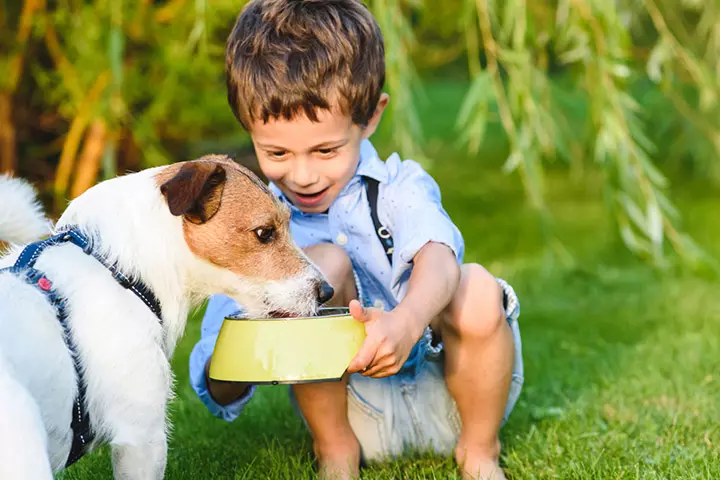
Image: Shutterstock
Being affectionate and gentle towards animals is one of the essential traits of an empathetic human being. So there are a few activities you can do:
- Have your children take care of their pets by tending to their needs, playing with them, or offering to take the neighbor’s pets for a walk.
- Let them make a bird feeder so the hungry birds can come and eat in peace. You may also encourage them to put water on the balcony on a hot day for the birds.
- Read them a book about being kind to animals so that they can understand their needs, likes, and dislikes.
Y. Chwyldro, a father, shares a personal incident to emphasize why it is important to teach empathy to children. He recounts, “My two-year-old had just finished the morning at nursery, and his little hand grasped my finger tightly as we walked home. Up ahead I noticed what I later learned to be a green shield bug. Relishing the opportunity to engage I walked him up to it and said ‘look,’ which he did, and reacted instantly. He killed it. A living creature, living no more (i).”
14. Kindness calendar
It will be like a to-do list of different acts of kindness. List out random acts of kindness, such as helping the elderly, paying for someone else’s meal at a restaurant, saying a few words of encouragement and appreciation to someone who needs it, and donating toys and clothes. They can tick out each time they accomplish one such deed. This will gradually make them helpful and empathetic.
15. Social awareness

Image: Shutterstock
Building social awareness in children could help them be open-minded and empathetic towards others. All of these activities are designed to develop social skills as well as self-awareness in children and you may also try others, such as “listening circles.” In this activity, divide the children into groups, and in each group, they will answer some get-to-know-you questions. It can be about their favorite animal, things that make them happy, or who they want to be as they grow up. As they exchange answers within themselves, they will be able to understand the other person and can build a strong and positive bond.
16. Student check-ins
This activity is more appropriate in a school setting. During check-ins, ask students to pause, explore, acknowledge, and appreciate their emotions. It makes them understand talking about their feelings is normal, and they need not worry about being judged. Knowing each other’s feelings will help children value emotions and learn empathy. Prepare a list of age-appropriate questions to ask the children. For young children, it may include simple queries such as what makes them happy, sad, or angry, what they should say to a sad classmate, or how they feel if no one listens to them. You may ask older students more complex questions.
Frequently Asked Questions
1. What are the best books or stories to read to teach children about empathy?
Some great books and stories that can help teach kids about empathy include “Wonder” by R.J. Palacio, “The Invisible Boy” by Trudy Ludwig, “Each Kindness” by Jacqueline Woodson, “The Giving Tree” by Shel Silverstein, and “A Sick Day for Amos McGee” by Philip C. Stead.
2. How can parents and teachers encourage children to consider how their actions impact others?
Parents and teachers can encourage children to think about how their actions impact others by modeling empathy and considering the consequences of their actions in front of the children. They can also engage in regular conversations with children about the importance of treating others with kindness and respect and discussing how actions can impact the emotions and experiences of others.
3. How can parents and educators use technology to teach empathy?
Parents and educators may use interactive digital media platforms to explore diverse perspectives and promote understanding. Immersive storytelling, virtual reality simulations, and collaborative problem-solving platforms can enhance empathy-building experiences. However, balancing screen time with real-world interactions is vital to reinforce empathy skills.
4. How to teach empathy to children with special needs?
To teach children with special needs, use visual aids, social stories, and role-playing activities to help them understand and relate to others’ emotions. Provide concrete examples and foster inclusive environments through activities focusing on recognizing and responding to emotions.
5. What are some effective ways to integrate empathy activities into daily routines?
Incorporating empathy activities into daily routines can be simple and meaningful. Parents can encourage children to express their feelings openly by asking questions like, “How did that make you feel?” during daily conversations. Reading stories that explore different perspectives also nurtures empathy by helping children understand diverse experiences. Additionally, parents can model empathetic behavior by sharing their emotions and discussing how they navigate challenging situations. Practicing small acts of kindness, like making cards for friends or helping someone in need, reinforces empathetic values. Over time, these activities help build a foundation of emotional awareness and compassion.
Encourage your children to consider others’ feelings and emotions with this collection of empathy activities for kids. Empathy and kindness are two of the most important moral values for kids. While many children display sympathy, only a few truly understand the other person’s point of view and empathize. If you teach the noble trait of empathy right from their childhood, they will grow to become humble, respectful, and kind. Now that you have this list make each day learning and meaningful for your children.
Infographic: Signs Your Child Is Learning Empathy
If you want your child to be kind towards others, empathy activities can be helpful. But how can you tell if your ways are working on them? You can know by observing their behavior and gestures that may seem usual but are signs of developing empathy. So here are a few of them that can help you spot empathy in your children. Illustration: Momjunction Design Team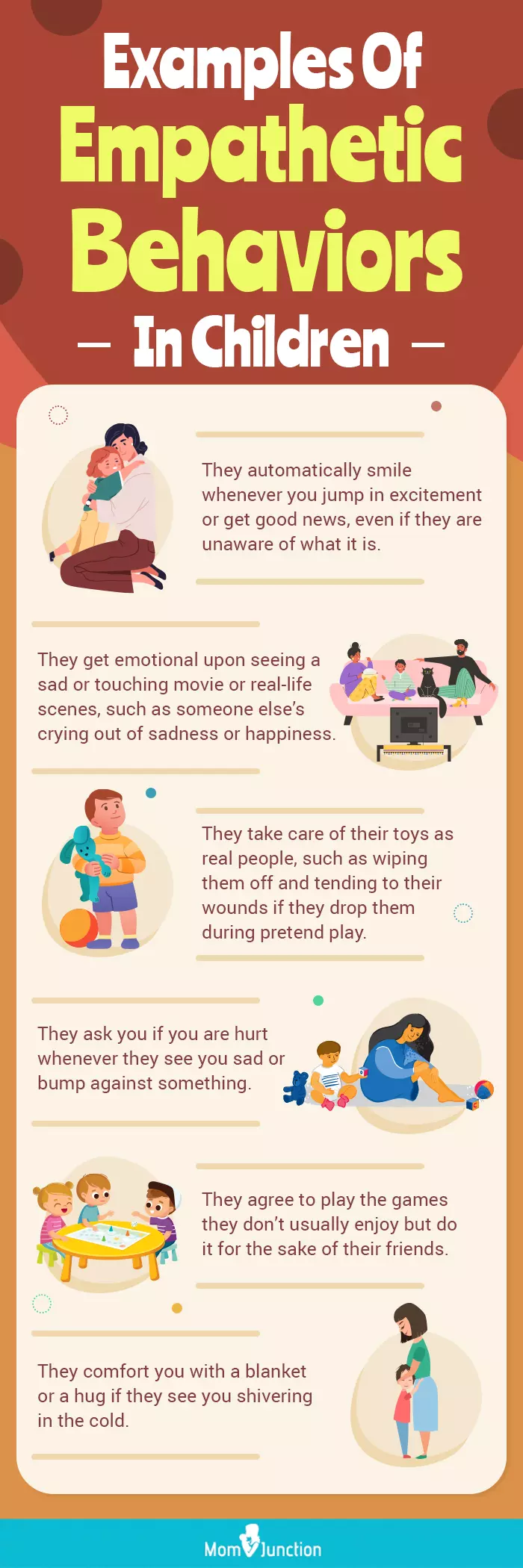
Illustration: Kindness And Empathy Activities For Kids To Learn
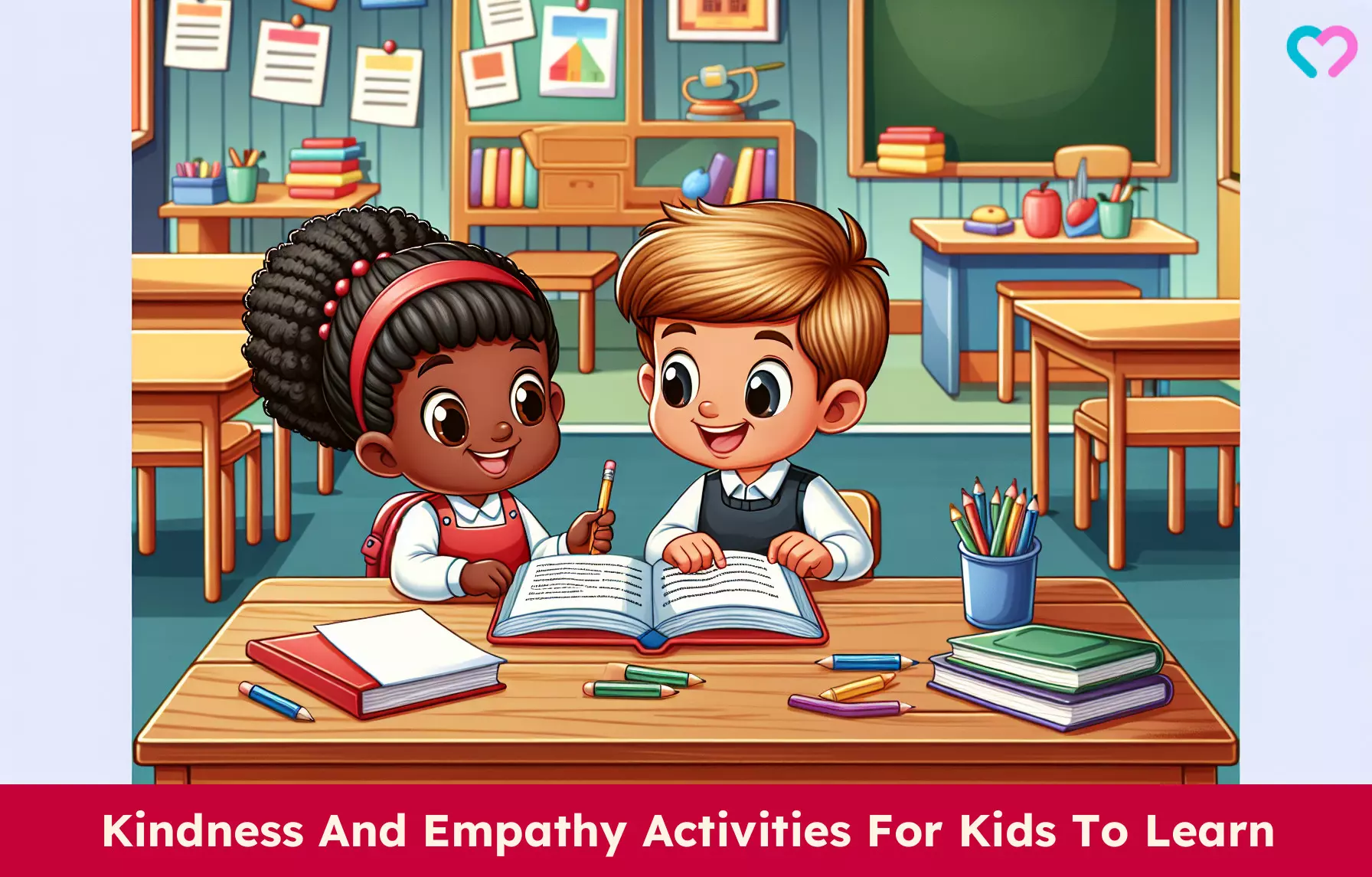
Image: Dall·E/MomJunction Design Team
Empathy activities can help us understand others better. Learn how to practice empathy with fun and engaging activities!
Personal Experience: Source
MomJunction articles include first-hand experiences to provide you with better insights through real-life narratives. Here are the sources of personal accounts referenced in this article.
i. How to raise a child with empathy.https://medium.com/alternative-perspectives/how-to-raise-a-child-with-empathy-60df3526dc64
References
- Kindness Counts: Prompting Prosocial Behavior in Preadolescents Boosts Peer Acceptance and Well-Being
https://journals.plos.org/plosone/article?id=10.1371/journal.pone.0051380
Community Experiences
Join the conversation and become a part of our nurturing community! Share your stories, experiences, and insights to connect with fellow parents.
Read full bio of Dr. Holly Schiff
Read full bio of Aneesha Amonz
Read full bio of Harshita Makvana
Read full bio of Apoorva K










